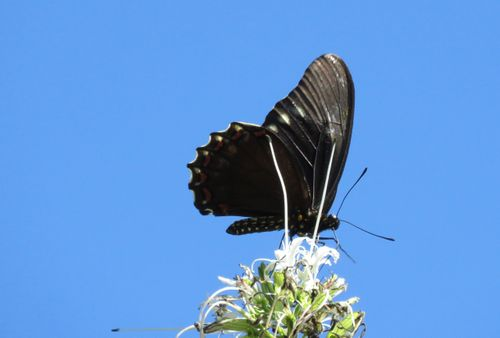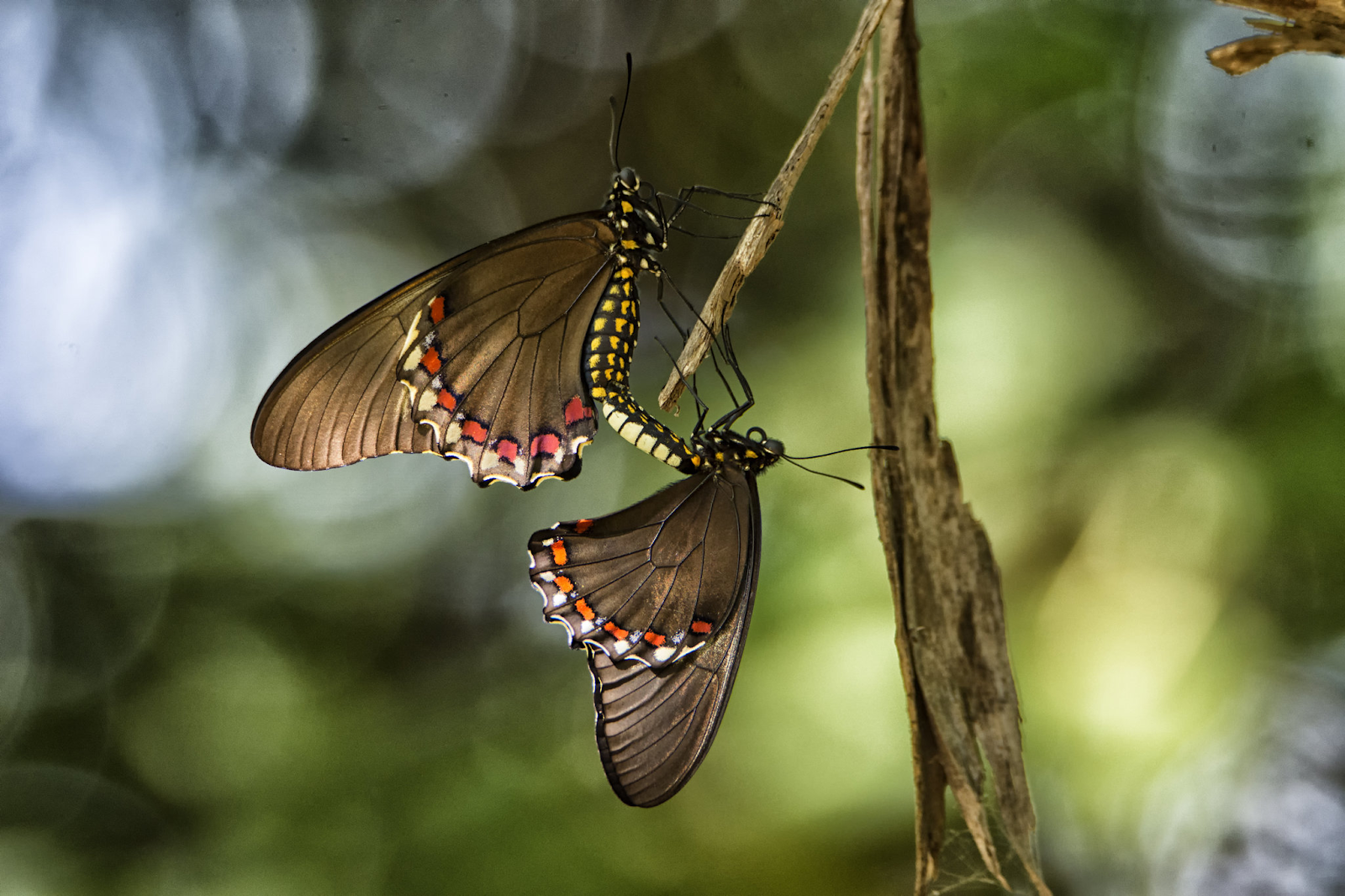Battus eracon, the West Mexican swallowtail, or Colima swallowtail, or Mexican Shadow, is a modest, dark swallowtail that does not actually have "tails" on its hind wings. Individuals can look iridescent blue in some lights, or fade to a dark drab color, but show little variation. More than most of the Battus group, their forewings show long, distinct tips that are free from the row of spots along the borders of the hind wings and the posterior halves of the fore wings. A gallery of museum specimens, showing the narrow range of variations, is at
Of butterflies that have the Swallowtail wing structure, most species have tails, some actively use the tails in flight, some don't, and some get by with no tails at all. In the genus Battus more species lack tails than have them. Some species, like philenor, may or may not have tails.
B. eracon is rare. Some people try to sell dead bodies to "collectors" who have gone to Colima, or Jalisco or Michoacan, and not seen one. The position of this web site is that one should never pay for a dead butterfly. By observing living butterflies for the time they are active, one will find dead ones, but it's harmful to tempt desperate students to kill living ones for money. Anyway, collecting boxes of dead bodies is unhygienic and obsolete. Collections of digital photos of living butterflies are nicer in every way.
Sometimes catalogued as if it were a separate species, because it can look like one, is the badly faded ab. incolorus, an "aberrant" form.
Though Mexicans have abundant reasons to appreciate their butterflies, which attract tourists and money from all over the world, they give the sheer richness of their diverse butterfly population as an explanation of why Mexican scientists have done relatively little rsearch on specific butterflies less dramatic than the Monarchs or Baronias. They are still exploring, still trying to work out just how much biogeographical wealth they are sitting on. Mexico is one of the world's ten most fertile fields for butterfly studies. Books like Jeffrey Glassberg's Swift Guide to the Butterflies of Mexico and Central America can only give a general idea of what's out there waiting for someone to learn more about it. This is one of the areas of knowledge to which any random tourist has a chance of contributing useful informatio, just by snapping a clear photo of a pretty butterfly visiting a pretty flower.
It is a pollinator, often attracted to flowering trees in forests. (In several ways Battus species resemble the Atrophaneuras; some count them as Batwings.) Although it can fly high above the ground it lives at low altitudes, not found more than 1000 feet above sea level.
Photo donated to gbif.org by Zihuadean. If you're at school you can read all the torrid details of how the butterflies pollinate one particular flower with a "psychophilous syndrome"! ("Psychophilous" means, of a flower, having an optimal shape for pollination by butterflies or moths. Plants suffering from a psychophilous syndrome may depend on a specific moth or butterfly to survive.)
Javier Hernandez was able to follow a couple of these butterflies. The distinction between male and female shows up clearly only in the photo of them together, though several nice clear pictures of the wings have been donated to inaturalist.org.
This pair were mating in Manzanillo in November--same time of year the caterpillar below was photographed. So generations overlap.
Apart from her gravid body shape, the female has bright yellow spots along her sides; the male has white spots, and the whole top surface of his back section looks white with thin black borders between segments.
The genus name Battus reflects the tradition of naming Swallowtails after characters in ancient literature. Battus was a shepherd boy who lacked the physical courage the ancient world admired. He saw some bigger fellows stealing sheep. Not wanting to be beaten up, he promised not to tell what he'd seen. Then he reported what he'd seen to the owner of the sheep. Possibly he didn't know that the owner, Hermes, was a Greek god with the power to find the sheep without mortal help, and was only asking to test Battus' courage. Although he did what businesses tell employees to do nowadays, the ancient world despised such non-aggressive behavior. Poor little Battus was turned to stone.
As a word eracon may have been created to name a genus of smaller butterflies in the Skipper family, to which we will eventually come if I live so long. (According to the same tradition whereby Swallowtails are placed at the beginning of lists of butterflies, Skippers are placed at the end.) Only recently was the "Erasmus Conference" named and abbreviated to EraCon. Online dictionaries don't list eracon as a Greek or Latin word or a given name. Eracon and Eragon are found as names, apparently of recent invention, for fictional characters, but not for characters in ancient literature. The butterflies may have been named after some otherwise forgotten person or family.
They were only identified as a species in 1897. Before that, if seen, they would have been presumed to be one of the tailless subspecies of B. philenor. Frederick D. Godman & Salvin argued that they were a distinct species because of the distinctive pattern of spots:
"A male of this distinct species differs from all forms of this section of Papilio found in Central America in having the spots of the secondaries in a submarginal series away from the cell and the costa, and beyond them are some small submarginal spots. Beneath the coloration of the margin of the secondaries is very marked ; besides the usual black margined rufous spots there are whitish spots between them, as well as ochraceous ones next the margin."
(Most of the Swallowtails were still being classified in the genus Papilio in the books available to me in the 1970s, though scientists had started assigning different genus names to the different types.)
The Spanish version of Wikipedia, which is the only version that has much to say about B. eracon, begins by acknowledging that despite this distinctive detail, in flight it looks very similar to the more common Battus species. (That would make it fairly large for a North American butterfly, but small relative to South American butterflies, with a wingspread of about three inches.) One reason why it's been so little photographed is that people who do see one will not necessarily notice that it's different.
Harmless to humans, the butterflies are toxic to animals that eat them. Like so many swallowtails, they get their protective toxicity and "warning" colors--in this case black--from a diet of Aristolochia leaves, in this case A. tentaculata. Eating the leaves of these wild vines gives the butterflies some small economic benefit to humankind: the caterpillars don't munch fast enough to destroy the vines altogether, but they slow the vines' growth and give trees a chance to grow.
(George Beccaloni has just made available online a real service to humankind. This PDF book lists, organized by plant families, the plants butterfly caterpillars are known to eat. You can download and print it:
The caterpillar has that bird-dropping camouflage thing going, though without the extravagant effort to look as if the bird who dropped it had had massive indigestion that some Battus caterpillars show.





No comments:
Post a Comment